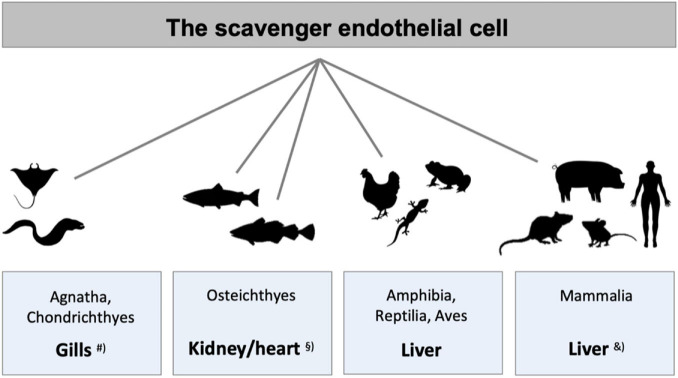FIGURE 3.
Species differences in the localization of main populations of scavenger endothelial cells (SECs). The figure illustrates the organs that harbor the main populations of specialized SECs in different vertebrate classes. #SECs are localized in special gill arteries in hagfish, lamprey (both Agnatha), and ray (Chondrichthyes) (Seternes et al., 2002). § In adult bony fish (Osteichthyes) SECs constitute the endothelium of the venous sinusoids in the kidney hematopoietic tissue in crucian carp (Seternes et al., 2002) and salmonid fish (Dannevig et al., 1990, 1994; Smedsrød et al., 1993; Seternes et al., 2002), and the atrial and ventricular endocardium in Atlantic cod (Smedsrød et al., 1995; Sørensen et al., 1997, 1998, 2001; Seternes et al., 2001a, 2002). In all higher vertebrate classes LSECs represent the major SEC population, studied in frog (Seternes et al., 2002), lizard (Seternes et al., 2002), chicken (Seternes et al., 2002), rodents (Smedsrød et al., 1990b; Seternes et al., 2002; Sørensen et al., 2015), and pig (Nedredal et al., 2003; Elvevold et al., 2004). &In addition to the central scavenger function of LSECs in mammals, studies in rabbit and rodents also show scavenging function of the sinusoidal endothelium in spleen, bone marrow, and lymph nodes (Fraser et al., 1983; Qian et al., 2009; Simon-Santamaria et al., 2014), and in pig, scavenging activity is reported in lung endothelium, in addition to LSECs (Nedredal et al., 2003).

